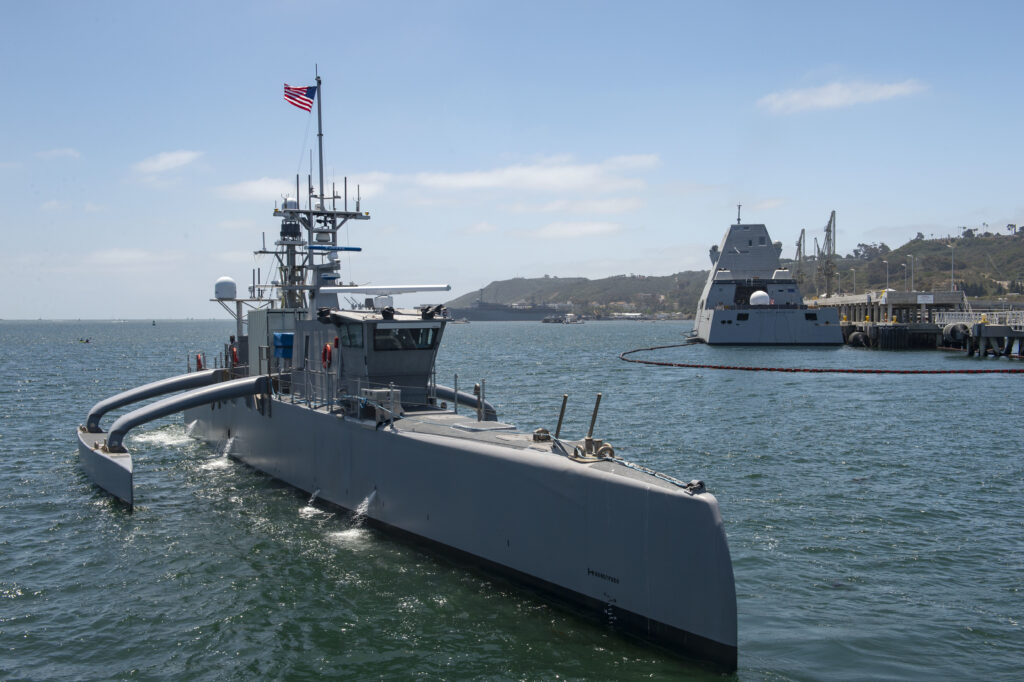
ARLINGTON, Va. — The Navy’s top officer said his thinking about integrating unmanned systems into the fleet has been changed by the observations of the service’s recent experimentation during fleet exercises.
“We are learning so fast in fielding these capabilities out to the fleet or potentially fielding them quickly inside the FYDP [Future Years Defense Plan] we may be able to close capability gaps with small, expendable unmanned [systems] off of any platform rather than thinking we have to build a larger [platform],” said Chief of Naval Operations Adm. Michael Gilday, speaking April 28 in a Maritime Security Dialogue event on the future of the U.S. Navy conducted by the U.S. Naval Institute and the Center for Strategic and International Studies, and sponsored by HII.
Gilday said by the time the DDG(X) program is underway “we will be in a better place with LUSV [large unmanned surface vehicle]. I don’t know if we’ll have an unmanned medium [USV] or not. The stuff that [U.S. 5th Fleet Commander Vice Adm. Brad] Cooper is doing with CTF-59 and using small, unmanned [systems] on the sea and in the air to sense the environment and make sense of it in order to yield a common operational picture for allies and partners as well as the 5th Fleet headquarters has changed my thinking on the direction of unmanned. … I’m not saying that we don’t need an MUSV [medium USV]; I’m saying it will cause us to consider numbers and what potential payloads they’re going to have.”
Gilday said unmanned systems have “so much potential, coupled with AI [artificial intelligence] software integration that it’s difficult to put a definitive number on the numbers we’re going to have in the air, on the sea, and under the sea. I like the way we’re going with the unmanned task force that has tied together acquisition specialists, requirements folks, scientists from the Navy research labs, and also the fleet with CTF-59 in terms of real-time exercising, experimenting, and developing CONOPS [concepts of operations]. It’s been a powerful awakening experience for us. Also, industry and foreign partners have dived in on this thing.”
Gilday said the Navy’s four experimental large and medium USVs — two Project Overlord vessels and the Sea Hunter MUSV and Sea Hawk USV — have accrued 41,000 nautical miles of autonomous travel so far.
“In terms of the mastery of COLREGS [Convention on the International Regulations for Preventing Collisions at Sea] and vessel avoidance, we think we’re in a really good place with that,” he said. “To send an unmanned [vessel] out into the ocean, with a mission, to expect that unmanned to come back and salute and say, ‘mission complete,’ is a different problem set. That’s something that we’re working on, but, quite frankly, that’s going to be a journey for us.”
Gilday said USVs may need to be “minimally manned for a while. I’d like to get to a place with large USVs where we can deploy them with strike groups and ARGs [amphibious ready groups] in the 2027-2028 time frame. A lot of the work we’re doing right now with the Unmanned Task Force and CTF-59 hopefully will buy down technical risk, make us an informed customer with respect to what we’re going to buy — both in engineering plant and a command-and-control framework — so that we can begin to deploy those things and do the same things we’re doing with CTF-59 to earn stuff out there as we’re using these LUSVs and perhaps medium USVs. I don’t want to wake up in 15 years and say, we bought the wrong kind of LUSV with the wrong engineering plant. … We’re trying to prove ourselves in an evolutionary, deliberate, informed kind of way.”
- BlueHalo to Test C-UAS System on Marine Corps JLTV - April 29, 2024
- USS George Washington Deploys to U.S. Southern Command, Eventually Headed to Japan - April 26, 2024
- SECNAV Advocates Increased Legal Immigration to Increase Shipbuilder Workforce - April 23, 2024



